
The North America Nebula (NGC7000, center) is a massive cloud of hydrogen gas and dust. In 1890, German astrophotographer, Max Wolf, noted the shape and coined the name.
Lower right is the Pelican Nebula (IC5070). The name Pelican Nebula was adopted due to the resemblance to a flying pelican. The flying bird is facing upward with the small nebula with the bright star in between, serving as the feet.
These are located about 2500 LY away from us. The North America Nebula alone is about 90 light years in diameter, and appears visually the size of 4 x 3 moons side by side.
Recent research has actually shown that these structures are actually one giant gas cloud. The reason that they appear as two nebulae is because there is a dark band of dust (L935) that obscures light positioned between them.
There is one powerful star positioned in between the two nebula, providing the ultraviolet energy that making both of these glow. Were the dust cloud not there, it would appear as one of the brightest stars in the sky.
In dark skies, binoculars or a telescope are required to see it. A camera is needed to get details.
I took this over 2 nights.
Scope: RASA8 (400mm fl)
Camera: ASI 2600mc
Mount ZWO AM5N
Control: ZWO ASI AIR plus
50 mm Svbony guide scope/ ASI 120mm
DSS
Processed in StarTools
5 min subs x 130
Stacked the best 80%
Clear skies,
This is the North America Nebula - so named because of it’s shape. It is a massive gas / dust cloud located near Cygnus. To the lower right lies the Pelican Nebula. This is a massive object about 4 moons x 3 moons. The red color is due to ionized hydrogen gas.
Click ALT for more info
#astronomy
27.09.2025 23:44 — 👍 67 🔁 9 💬 0 📌 0
Yes, soon in terms of astronomical times. Soon meaning a million years or so. That’s a blink of an eye for the universe. Cheers,
26.09.2025 13:01 — 👍 1 🔁 0 💬 0 📌 0
You might be right. I’ve read both, and think S&T is a little more techie. I get Astronomy - quick read. The pic I used from them was a pic I shot from the mag. Sure color was washed out. Does show the exquisite detail the photographer got. I didn’t match that, but I’m shooting in Bortles 7.
26.09.2025 12:57 — 👍 0 🔁 0 💬 0 📌 0
Thanks. I have bottles 7 skies, and I’ve struggled to get details of M31. I was particularly pleased that in this image, I was able to get the bright nebulae to show up. Not as clearly as the Astronomy Magazine image, of course, but nonetheless, it made my day.
25.09.2025 13:36 — 👍 0 🔁 0 💬 0 📌 0
I would loved to have the chance, but so far, I’ve been confined to the Northern Hemisphere. Would be an interesting object to image.
24.09.2025 17:31 — 👍 1 🔁 0 💬 0 📌 0
Thx. It’s taken a while to learn how to do this kind of photography. 😀. Glad you enjoyed seeing them.
24.09.2025 17:26 — 👍 1 🔁 0 💬 1 📌 0

Andromeda Galaxy, M31
So named because it resides in the constellation Andromeda. Andromeda, as you recall was the princess saved by Perseus from the Kraken.
M31, a barred spiral galaxy, is huge with over trillion stars - estimated to be 3X bigger than our Milky Way. It is also visually huge - bigger than 6 moons in length and 2 moons across. Note the two satellite galaxies, M210 (below center) and M32 (located in the upper arm left of center. These are both dwarf galaxies.
At 2.5 million LY away M31 is the closest complete galaxy to ours. It’s diameter is estimated to be 152,000 LY. Interestingly, M31 is moving towards the Milky Way, and the two are expected to merge in a few billion years!
To be clear, M31 is not the closest galaxy to us. There are, of course, an estimated 50+ dwarf galaxies that surround our Milky Way, but these lack a complex structure, and are thought not to have a black hole in their centers. Many of these dwarf galaxies are much more like star clusters.
I’ve taken many pics on M31 over the years. While an easy target because of the brightness, bringing out details without over processing - which makes it look artificial - has always been challenging. I think I was finally successful. You be the judge.
Scope: RASA 8
Camera: ASI 2600 MC
Mount: Celestron AVX
Guide: Sbvony 50mm/ASI 120 mini
Control: ASI Air Plus
Stack: DSS
Process: StarTools
Exposure: 180 sec X 120 subs collected over 2 nights.
I stacked the best 70% of the subs.
The first pic is mine from a couple of nights ago. The 2nd pic was published in Astronomy Magazine this month. It is the work of: Adriano Anfuso.

Andromeda Galaxy
Picture published in Astronomy Magazine, October 2025. Work of: Adriano Anfuso.
This is the Andromeda galaxy. It is the nearest complete galaxy to us at about 2.5 M LY away, containing over a trillion stars. So bright, it can be seen with the unaided eye in clear skies. My pic is the first. The 2nd was in Astronomy Magazine this month.
Click ALT for more info
#astronomy
24.09.2025 13:51 — 👍 45 🔁 9 💬 4 📌 0
Gene, thx for the kind comments. I started into astrophotograhy with an SE-8. Have been trying different scopes ever since. It does take a long time to master digital photography, but your C8 will be great for the planets and for planetary nebulae. Cheers, Doug
20.09.2025 12:17 — 👍 1 🔁 0 💬 0 📌 0

Polaris
When we think about orbiting objects, we naturally think about the planets. But actually it is common for stars to orbit other stars as well. For this to occur, the stars must be close enough that they become gravitationally bound to each other. These systems are called binary star systems. Almost always, the stars are close enough together that they visually appear as a single star to the eye.
A famous example is Polaris, our North Star (shown below). Visually a single star, but with a telescope the small companion star emerges.
Another popular double star is Albireo. With one blue and one yellow star it is a visually striking example binary system and popular with backyard astronomers because of the easily-distinguished colors.
But the fun doesn't stop there!. There are triplet and quadruplet star systems as well. The star Omicron Cygnus (below) is a triple star system. It is also known as the red, white, and blue star system. To the eye it appears as one star, but with binoculars or a telescope, it is easily resolved into the three stars. The red is center, the blue is left and the white is right. The different colors are because these are different types of stars.
Epsilon Lyra is an even more complex system made up of four stars. Two closely paired binaries are orbiting each other. It is particularly striking because of the symmetry. It is a single star to the eye. Separating it into two stars is easily done with binoculars, but to resolve the tight binaries, you will need a good scope. But what a treat when you see it!
So grab your binoculars and telescopes. To locate these, open up your favorite phone app and it will guide you to these gems. All are visible in the Northern Hemisphere this time of year.
Clear skies,
Doug

Albireo

Omicron Cygnus

Epsilon Lyra
How often have you looked up in the sky and seen a star and thought..... "OK. That's just another star", and you move your attention to something else? Well, to be honest, I used to do so too. Not necessarily anymore.
Click ALT on pics for the star’s names and more info
#astronomy
19.09.2025 22:36 — 👍 18 🔁 0 💬 2 📌 0
Thx much for the kind comment!
02.09.2025 19:05 — 👍 1 🔁 0 💬 0 📌 0

The indicated star is Cygnus X-1. The binary pair consists of a supergiant star (about 20 solar masses), and an estimated 15 solar mass black hole. The pair is located about 7000 LY from us. Cygnus X-1 is one of the strongest X-Ray sources from space that we can detect. It produces X-Ray bursts that last milliseconds.
The pair orbit each other every 5.8 days.
You cannot see the black hole, of course, but it presence is detected because of the effect it has on the companion star and the effect of the high-energy X-Rays on the surrounding area.
The Tulip Nebula (SH2-101) is not the easiest target to image. At mag 9, it is a requires lots of data collection and cooperative skies. In fact its total brightness is less than that of the star we were talking about. It is an emission nebula, about 6000 LY from Earth. It was first catalogued in 1959.
SH 2-101 is a challenging target to image. It’s located in the Milky Way and there are tons of stars in front of it. To enhance it, I removed the stars, developed the nebula alone hi, and then added it to the image containing the stars.
Clear skies,
Doug
This is my re-do of the Tulip Nebula, SH 2-101. It’s an attractive nebula, but what makes it even more interesting is that the black hole Cygnus X-1 is nearby. It is in a binary system where Cygnus X-1 and an observable star orbit each other. So cool!
Click ALT for more info
#astronomy
02.09.2025 17:31 — 👍 43 🔁 6 💬 1 📌 0

I took this image of the Eastern Veil Nebula (NGC6992) last night. I’ve imaged it several times over the years, but haven’t been satisfied enough to share till now. The Western Veil Nebula that I posted yesterday is the other half of it.
The Eastern Veil Nebula, is part of the remnants of a supernova from a massive star, some 20x bigger than our sun. That exploding star (supernova) created this massive cloud of dust and gasses. Astronomers estimate the explosion took place some 10-20,000 years ago. The supernova would have then been brighter in the sky than Venus and visible in the daytime sky - even though it is about 2,400 LY away.
Since the supernova, the remnants have expanded to about 3 visual degrees which is equivalent to 6 moons lined up. So this is a BIG object in the sky! It’s fun to think what our night sky would look like if objects like this were brighter (or closer).
This is located near an arm of the Milky Way, near Cygnus the Swan, so there are plenty of stars in the background. It is positioned almost directly overhead at midnight this time of year - but you will need a telescope equipped with a camera to see it. Nearby stars are bombarding this gas/dust cloud with energy, making it glow. The red is from the presence of hydrogen, and the blue from oxygen.
Satisfied with the detail in this pic.
Enjoy,
Doug
This, the Eastern Veil Nebula, is the other half of the supernova remnant that I posted yesterday. The debris expanding over the past 15K years or so, giving the current very large structure. Both are particularly beautiful due to the amount of oxygen (blue).
Click ALT for more info
#astronomy
01.09.2025 16:43 — 👍 124 🔁 16 💬 0 📌 0
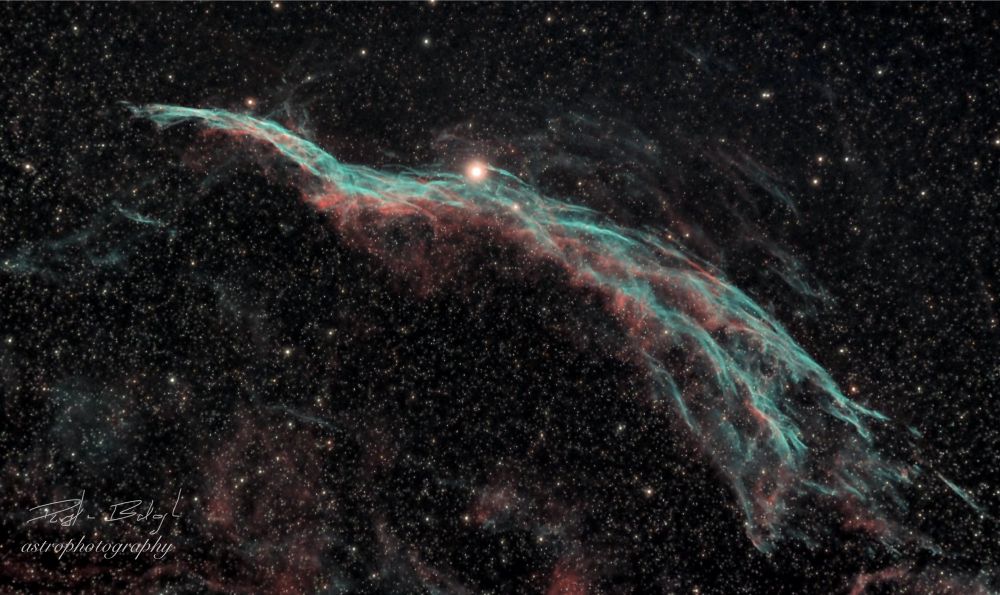
I took this image of the Western Veil Nebula (NGC6960) last night. I’ve imaged it several times over the years, but haven’t been satisfied enough to share till now.
The Western Veil Nebula, or Witches Broom Nebula, as it is also called, is the remnant of a supernova from a massive star, some 20x bigger than our sun. That exploding star (supernova) created this massive cloud of dust and gasses. Astronomers estimate the explosion took place some 10-20,000 years ago. The supernova would have then been brighter in the sky than Venus and visible in the daytime sky - even though it is about 2,400 LY away.
Since the supernova, the remnants have expanded to about 3 visual degrees which is equivalent to 6 moons lined up. So this is a BIG object in the sky! It’s fun to think what our night sky would look like if objects like this were brighter (or closer).
This is located near an arm of the Milky Way, near Cygnus the Swan, so there are plenty of stars in the background. It is positioned almost directly overhead at midnight this time of year - but you will need a telescope equipped with a camera to see it. Nearby stars are bombarding this gas/dust cloud with energy, making it glow. The red is from the presence of hydrogen, and the blue from oxygen.
Let your imagination run a little bit, and you can see how it got its nickname of the “Witches Broom.”
Enjoy,
The Witches Broom Nebula is the remnant from a supernova from 10-20K years ago. Nearby stars energize the dust/gas cloud that formed from the explosion and make it glow. It’s a big object - as long as 6 moons side by side. Telescope needed to view.
Click ALT for more info
#astronomy
31.08.2025 20:15 — 👍 117 🔁 17 💬 3 📌 2
Meant to say: …..binary star with a “black hole” as its partner.
20.08.2025 00:21 — 👍 0 🔁 0 💬 0 📌 0

The indicated star is Cygnus X-1. The binary pair consists of a supergiant star (about 20 solar masses), and an estimated 15 solar mass black hole. The pair is located about 7000 LY from us. Cygnus X-1 is one of the strongest X-Ray sources from space that we can detect. It produces X-Ray bursts that last milliseconds.
The pair orbit each other every 5.8 days.
You cannot see the black hole, of course, but it presence is detected because of the effect it has on the companion star and the effect of the high-energy X-Rays on the surrounding area.
The Tulip Nebula (SH2-101) is not the easiest target to image. At mag 9, it is a requires lots of data collection and cooperative skies. In fact its total brightness is less than that of the star we were talking about. It is an emission nebula, about 6000 LY from Earth. It was first catalogued in 1959.
This is not a great image of SH2-101, and I may try to improve on this sometime, but the black hole binary was so interesting, I wanted to share it.
Clear skies,
Doug
I was collecting the tulip nebula last night. The nebula is faint and will require lots more data. But my research led to find that the indicated star is a binary star with a as its partner.
Not that much to look at, but fun to know about.
#astronomy
Click ALT for more info.
19.08.2025 20:57 — 👍 11 🔁 1 💬 1 📌 0
Impressive for 30 sec. For sure you would need to mount it on an equatorial mount and add a guide scope. I started with an SE8 and 30 sec exposures. It got all of hand after I got an equator mount and camera. 😀
04.08.2025 22:59 — 👍 0 🔁 0 💬 2 📌 0
I’ve got a friend with a vintage 9”Takahashi SCT. It too has wonderful optics, but the baffles designed to increase contrast, in turn restrict the width of the field of vision. I’ll bet you may have a similar experience. That said, there are plenty of objects that the scope will be perfect for.
04.08.2025 22:33 — 👍 1 🔁 0 💬 1 📌 0
I’d love to see what that wonderful scope could produce with a dedicated camera. Cheers.
04.08.2025 15:25 — 👍 1 🔁 0 💬 1 📌 0
John,
I would love to see what your wonderful Questar 7 would do with a dedicated camera attached. That’s one heck of a telescope.
04.08.2025 14:55 — 👍 1 🔁 0 💬 0 📌 0
You got it! I can make out the shadow and Titan. Your set up did well for itself. My 4” refractor which I had set up for other stuff was abysmal with Saturn.
04.08.2025 02:56 — 👍 1 🔁 0 💬 0 📌 0
Thx John,
I checked out your page. Some nice astro pics there.
03.08.2025 23:07 — 👍 1 🔁 0 💬 0 📌 0
You are welcome. Glad you found it interesting.
03.08.2025 19:37 — 👍 0 🔁 0 💬 0 📌 0
Light pollution is probably your biggest noise source. Filters help a lot. To get into photography you will need a guided mount. Your suggestion of the SeeStar is a great solution if you are on a budget.
03.08.2025 18:13 — 👍 1 🔁 0 💬 0 📌 0
I’ve been recommending the SeeStar S30/S50 and the DwarfLab to astronomers on a budget, as well as for travel.
Got friends with an S30, a DwarfLab 3, and I own a Dwarf 2 that I got used real cheep. The S50 is the most powerful, with the biggest objective lens - update rumored.
You’ll love it.
03.08.2025 18:09 — 👍 1 🔁 0 💬 0 📌 0
Scope is a Celestron C11. ZWO 533Mc camera; IR/UV cutoff filter; ZWO AM5N mount. Not guided because I took videos. ASI AirPlus controller. Abt 2000 frames each. Stacked 40%.
03.08.2025 17:27 — 👍 3 🔁 0 💬 1 📌 0
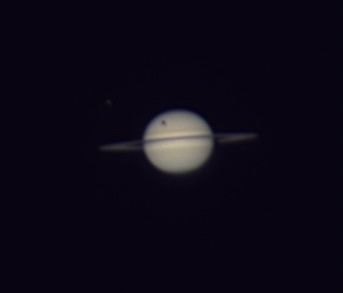
You can see Titan’s shadow on the upper left of Saturn. In my next picture taken about 30 min later, you can see the shadows moved towards the center of Saturn, due to the orbit of Titan, wrt the location of the sun.
My 3rd pic is purposely over exposed to show the moons Rhea (far left), Titan left high above the rings, and Dione (right immediately above the ring).
Titan is the 2nd largest moon in the solar system (Jupiter’s Ganymede is the largest). To put that in perspective, Titan is larger than the planet Mercury.
The 15-year-ish cycle is due to Saturn’s tilt on its axis, so like Earth, it has seasons. Its long slow orbit around the sun account for the long cycle. So for a shadow to be seen from Earth, Titan must be in just the right spot.
Titan orbits Saturn once every 16 days, so we actually get to see the shadow about a half dozen times on a 16 day cycle during the transit year. Then Saturn’s tilt changes enough and the shadow no longer hits Saturn. Aug 29, Sept 4, and Sept 20 are the last chances to see the transit. You will need a pretty good telescope, however to see the shadow. I tried my 4” 900 mm refractor, but was disappointed.
Tech stuff:
Scope 11” SCT focal length 3000 mm
Mount: ZWO AM5N
Camera: ZWO 533MC
Video: about 40% of 2000 frames stacked
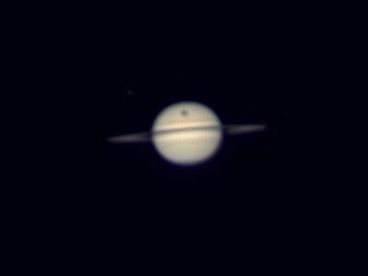
Titan’s shadow mid transit, Aug 3 4:50 AM, EDT
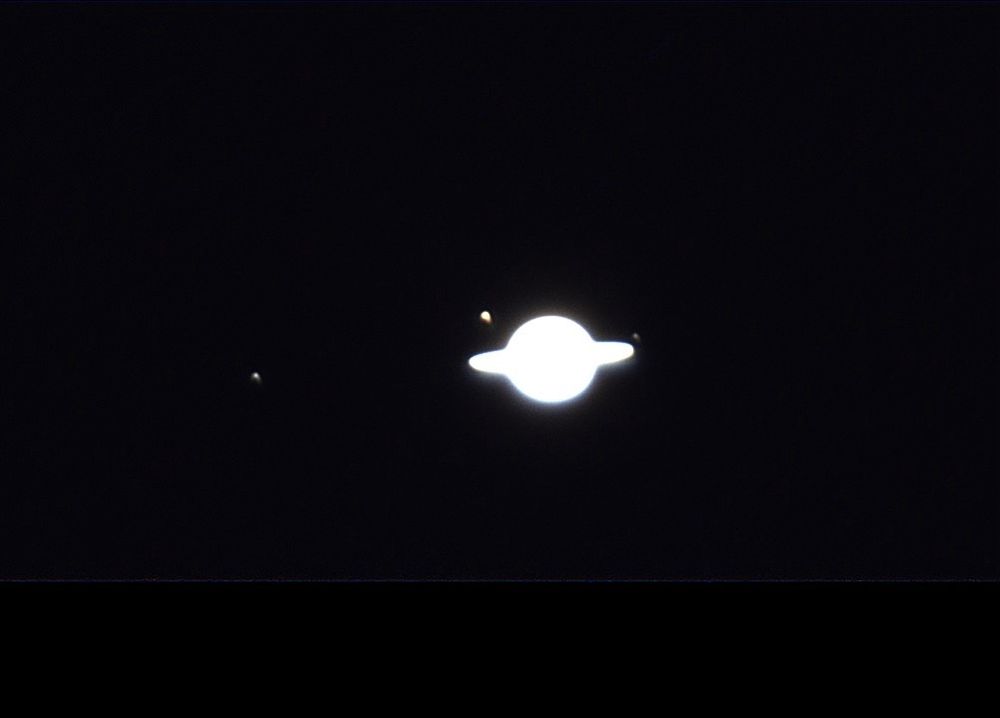
Saturn’s moons Rhea (far left), Titan (left above the rings), Dione (right just above the rings).
Saturn’s moon Titan casts its shadow on Saturn where we Earthlings can see it once every 15 (or so) years. Even then, you have to be in the right location. North America was the right location for 2025. I took these last night.
Click ALT on the first pic for more info
#astronomy
03.08.2025 15:23 — 👍 269 🔁 33 💬 7 📌 0
I’ve been recommending the SeeStar (and DwarfLab) for astronomers on a budget in the programs I do. Nice pieces of technology.
Suspect you will be challenged to see some of the Southern M objects from up in Alaska. But no light pollution will make the others so much easier.
Clear skies,
31.07.2025 17:34 — 👍 1 🔁 0 💬 0 📌 0
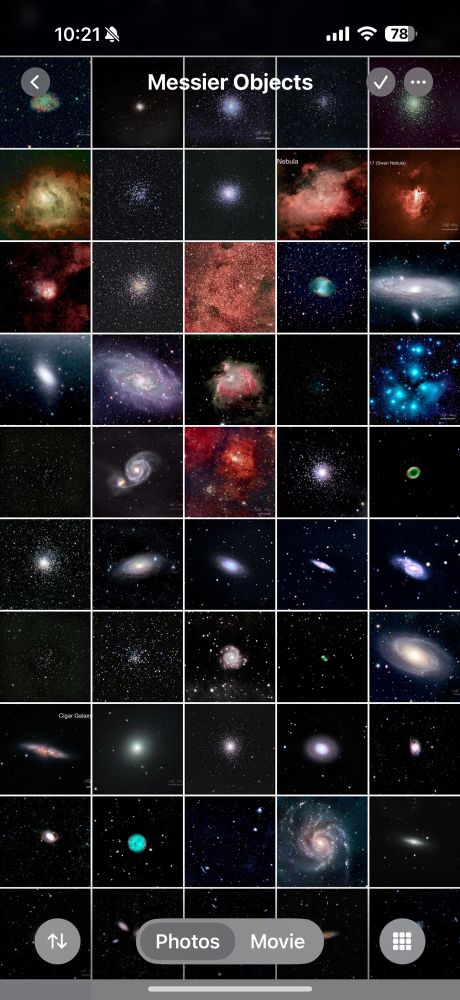
Charles Messier was an astronomer active in the late 1700’s. His interest was comets, and he would sit in his roof-top in Paris and search the heavens at night.
Of, course, light pollution was not a thing in Paris at that time.
The best telescopes of the time were about as powerful as the beginner scopes are today. Thus, to Messier, the objects we now to know as galaxies, star clusters and nebulae appeared only as fuzzy patches of light. Just like the comets he was searching for.
So to avoid confusion on whether he was finding a new comet, or simply finding one of these non-comet objects, he created a catalog of the objects he did not want to find again. Other astronomers of the time helped him and the list grew to 100 objects. Later 10 more objects were added, and the list now stands at 110 objects.
The Messier Objects catalog is very popular with backyard astronomers because many of the objects in it are fairly bright making them easy to locate for the amateur.
It’s kind of funny to think that this list of unwanted objects, is now the # 1 list for amateur astronomers.
I expect to be conspiring all of these in about 6 months. Some are not visible for a while.
The Messier catalog is a popular list of astronomy targets for backyard astronomers, and I’m working my way through it. I have about 50 so far out of 110. I will be periodically updating this post as I add more images.
For more on Charles Messier, click on ALT
#astronomy
31.07.2025 15:57 — 👍 32 🔁 7 💬 0 📌 1

According to various sourses:
Solar flares are sudden, intense bursts of electromagnetic radiation from the sun's atmosphere that appear as bright flashes of light. Flares occur near sunspots where opposite magnetic fields meet. They can last minutes to hours and release energy, light, and high-speed particles into space.
Flares are often linked to coronal mass ejections (CMEs), which are solar magnetic storms. When CMEs are aimed at Earth, we may be treated to Northern Lights, and may experience interruption of communications and GPS.
The sun’s magnet field switches on an 11-year cycle. Solar activity is most intense during the middle of the cycle, which we are in now. It is not understood why the magnetic poles flip. In a few years, the sun’s magnet field will be “calm” and there will be long periods without any sunspots or flares.
I have included NASAs image, and have oriented my image to align with NASAs. The NASA image was taken from space, with highly specialized equipment, but it is interesting to compare what we can see on Earth vs NASA.
Tech stuff:
Scope - Lunt LS50, double stack
Camera - ASI 533MC
Stack: ASI video stack
Process: Mac
Image is a composite to enhance the flares.

Yesterday was an active day for solar flares. It takes a special Hydrogen alpha telescope to see solar flares. One of my better. The sun goes through an 11-year activity cycle in which the poles flip. Mid cycle is the most active time.
Click ALT for much more info
#astronomy
30.07.2025 14:52 — 👍 12 🔁 2 💬 0 📌 0

NGC543 aka the "Cat's Eye" nebula is a planetary nebula located in Draco. Discovered in 1876 by William Herschel, it is one of the most complex planetary nebulae known. Hubble has revealed knots, jets, bubbles and complex arcs, illuminated by a central hot planetary nucleus. At the center of it all is a dying Wolf-Rayet star. In addition, the Hubble has shown a dart-board pattern of concentric rings emanating from the center. There is also a much fainter and larger outer ring. Wow, right!
Located about 3000 LY from us, the nebula is estimated to be about 1000 years old (meaning it is actually 4000 years old now).
Wolf-Rayet (W-R) stars are exceedingly rare. Of the 100 billion stars in the Milky Way, only about 1000 are estimated to be W-R stars. W-R stars are abt 20x bigger than our sun, all that mass causes them to live out their lives in only 1 million years instead of the 10 billion years like our sun. As a result, they burn 20x the fuel 10,000x faster than our sun. Their short lives are incredibly bright! The dying W-R is throwing off materials as it dies which has formed the complex structures in the nebula. Eventually, the W-R will explode into a supernova destroying this nebula, but leaving behind other remnants which may form a new nebula.
The size of the core is 20" (90x smaller than the moon) and it appears as a faint fuzzy star to the eye. Include the outer ring and the size is about 6 arc minutes (1/4 the size of the moon). Taking a single picture of the core and the faint outer ring is difficult. Instead, I took 2 images using different scopes. The star at 8:00 in the core pic sits on the ring.
Tech stuff:
Scopes (core): C11; (ring): RASA 8
Mounts (core): AM5N; (ring): AVX
Camera: ZWO2600 MC (used same camera on both)
Guides (core): Skywatcher 50ED-ZWO 290MM; (ring) SVbony 60mm-ZWO120MC
Subs (core): 2 sec x 120; (ring): 5 minutes x 40
Stacking (core): ASI Deep Stack; (ring): DSS
Processing: StarTools (both)

NGC543 aka Cat's Eye nebula is the most complex known to exist. Center is a dying Wolf-Rayet star responsible for creation. It has a very faint outer ring. The small core/larger faint ring make this a challenging target. I ended up using 2 different scopes.
Click ALT for much more info
#astronomy
26.07.2025 23:32 — 👍 33 🔁 1 💬 0 📌 0


















